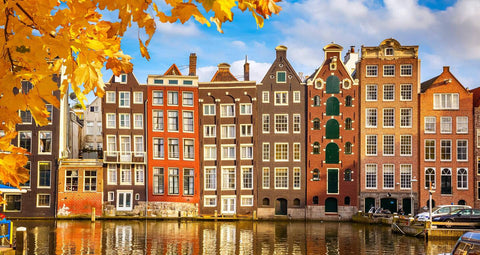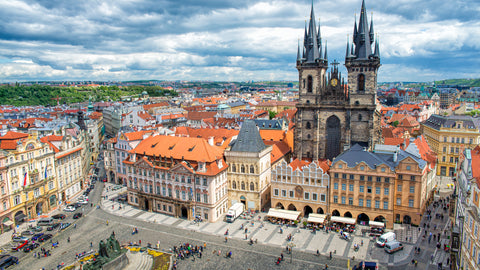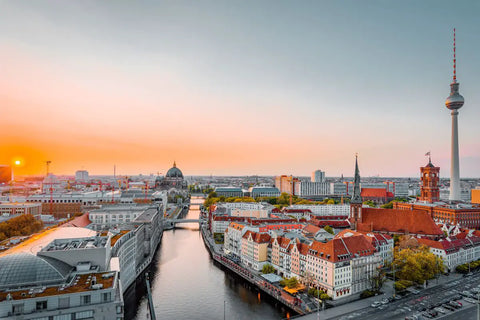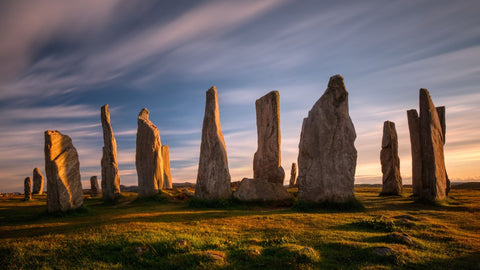Die 5 besten Solo-Reiseziele in Europa für Ihr nächstes Abenteuer
1. Amsterdam, Niederlande

Amsterdam ist eine Stadt, die für jeden etwas zu bieten hat. Ob Sie sich für Kunst, Geschichte, Architektur, Nachtleben oder Natur interessieren, Sie werden zahlreiche Attraktionen und Aktivitäten finden, die Ihren Interessen entsprechen. Amsterdam ist außerdem eine sehr freundliche und einladende Stadt mit einer toleranten und multikulturellen Atmosphäre. Sie werden kein Problem damit haben, neue Leute kennenzulernen und Freundschaften zu schließen, da die Einheimischen im Allgemeinen fließend Englisch sprechen und hilfsbereit sind. Amsterdam ist außerdem eine sehr sichere und einfach zu navigierende Stadt mit einem effizienten öffentlichen Verkehrssystem und einem Netz von Radwegen. Sie können ein Fahrrad mieten und die Stadt wie ein Einheimischer erkunden oder in die Straßenbahn, den Bus oder die U-Bahn steigen, um sich fortzubewegen.
Was es zu sehen und zu tun gibt?
Amsterdam hat so viele Dinge zu sehen und zu tun, dass Sie von der Auswahl vielleicht überwältigt werden. Hier sind einige der Sehenswürdigkeiten und Aktivitäten, die ich Alleinreisenden empfehle:
- Besuchen Sie das Anne-Frank-Haus, wo Sie mehr über das Leben und Tagebuch des jungen jüdischen Mädchens erfahren können, das sich während des Zweiten Weltkriegs vor den Nazis versteckte. Dies ist ein sehr bewegendes und lehrreiches Erlebnis, aber seien Sie mit langen Warteschlangen rechnen, da dies eine der beliebtesten Attraktionen in Amsterdam ist. Sie können Ihre Tickets im Voraus online buchen, um Warteschlangen zu vermeiden.
- Erkunden Sie das Rijksmuseum, das größte und renommierteste Museum der Niederlande, wo Sie Werke berühmter niederländischer Künstler wie Rembrandt, Vermeer und Van Gogh bewundern können. Das Museum zeigt auch die Geschichte und Kultur der Niederlande vom Mittelalter bis zur Gegenwart. Sie können hier problemlos einen ganzen Tag verbringen, planen Sie Ihren Besuch also entsprechend.
- Genießen Sie die Kanäle, das Wahrzeichen Amsterdams, das der Stadt ihren Charme und Charakter verleiht. Sie können eine Bootstour unternehmen und auf den Wasserstraßen fahren und dabei die malerischen Brücken und Häuser bewundern. Sie können auch zu Fuß oder mit dem Fahrrad am Kanalufer entlang gehen und unterwegs in Cafés, Geschäften und Märkten Halt machen. Sie können auch einige der Grachtenhäuser besichtigen, die in Museen umgewandelt wurden, wie das Museum Van Loon oder das Museum Willet-Holthuysen.
- Entdecken Sie die Landschaft, die nur eine kurze und einfache Fahrt von Amsterdam entfernt ist. Sie können mit dem Zug oder Bus in einige der nahe gelegenen Städte und Dörfer fahren, wo Sie die traditionelle niederländische Landschaft mit Windmühlen, Tulpen und Käse bewundern können. Sie können auch ein Fahrrad mieten und durch die Felder und Bauernhöfe radeln und dabei die frische Luft und die Landschaft genießen.
2. Barcelona, Spanien

Barcelona ist eine Stadt, die Geschichte, Kultur und Moderne auf faszinierende Weise vereint. Es ist die Hauptstadt Kataloniens, einer Region mit eigener Sprache, Identität und Traditionen. Barcelona ist außerdem ein wichtiger Mittelmeerhafen und ein Zentrum für Innovation und Kreativität. Ob Sie sich für Kunst, Architektur, Küche oder Nachtleben interessieren, in dieser lebendigen und vielfältigen Stadt gibt es viel zu genießen und zu entdecken.
Einige Dinge, die Sie bei einem Besuch in Barcelona nicht verpassen sollten, sind:
- Sagrada Família, das Meisterwerk von Antoni Gaudí, dem berühmtesten Architekten des katalanischen Modernismus. Diese seit 1882 im Bau befindliche Basilika ist ein beeindruckendes Beispiel für organisches und symbolisches Design, inspiriert von der Natur und dem christlichen Glauben. Sie können die komplizierten Fassaden, die hohen Türme und die farbenfrohen Buntglasfenster bewundern sowie das Museum und die Krypta besuchen.
- Park Güell, eine weitere Schöpfung Gaudís. Dieser Park ist ein skurriler und bezaubernder Ort, an dem Sie seinen unverwechselbaren Mosaik-, Skulpturen- und Architekturstil bewundern können. Sie können durch die Gärten, die Denkmalzone und das Gaudí-Hausmuseum spazieren, in dem er einige Jahre lebte.
- La Rambla, die berühmteste Straße Barcelonas, ein belebter und belebter Boulevard, der von der Plaça de Catalunya bis zum Hafen führt. Sie können durch die Fußgängerzone schlendern, wo Sie Straßenkünstler, Künstler, Blumenstände und den berühmten Boqueria-Markt sehen können. Unterwegs können Sie auch einige Sehenswürdigkeiten besichtigen, wie das Opernhaus Liceu, den Palau de la Virreina und das Kolumbus-Denkmal.
- Gotisches Viertel, der älteste Teil der Stadt, wo Sie die engen Gassen und Plätze erkunden können, die den mittelalterlichen Charme und die Geschichte Barcelonas bewahren. Sie können einige der Wahrzeichen sehen, wie die Kathedrale, das Rathaus, den Palast der Generalitat und die Basilika Santa Maria del Mar. Sie können auch die Atmosphäre der Bars, Restaurants und Geschäfte in der Gegend genießen.
3. Prag, Tschechische Republik

Prag ist die Hauptstadt und größte Stadt der Tschechischen Republik und die historische Hauptstadt Böhmens. Sie ist eine der schönsten und kulturell schönsten Städte Europas mit einem reichen architektonischen Erbe, das von der Romanik bis zur Moderne reicht. Prag ist auch als „Stadt der hundert Türme“ bekannt, da hier viele Kirchtürme das Stadtbild prägen. Prag liegt am Ufer der Moldau und bietet malerische Ausblicke und Brücken wie die berühmte Karlsbrücke. Prag ist eine Stadt, die Sie mit ihrem Charme, ihrer Geschichte und ihrer Kunst verzaubern wird.
Einige Dinge, die Sie bei einem Besuch in Prag nicht verpassen sollten, sind:
- Prager Burg, die größte antike Burg der Welt, wo Sie die beeindruckende St. -Veits-Dom, den Königspalast, das Goldene Gässchen und die Gärten. Genießen Sie auch die Wachablösung und den Panoramablick auf die Stadt vom Burgberg aus.
- Altstädter Ring, das Herz des historischen Zentrums von Prag, wo Sie die gotische Frauenkirche vor dem Teyn, die barocke St. -Nikolaus-Kirche, das Rokoko-Kinský-Palais und das Alte Rathaus mit seiner berühmten astronomischen Uhr, die jede Stunde ein Schauspiel beweglicher Figuren zeigt.
- Jüdisches Viertel, das ehemalige Ghetto von Prag, wo Sie die Altneusynagoge, die älteste aktive Synagoge Europas, das Jüdische Museum, das die Geschichte und Kultur der jüdischen Gemeinde in Prag zeigt, besichtigen können der Alte Jüdische Friedhof, auf dem Tausende von Grabsteinen übereinander gestapelt sind.
- Petřín-Hügel, eine grüne Oase in der Stadt, wo Sie eine Seilbahnfahrt oder eine Wanderung auf den Gipfel unternehmen können, wo Sie den Petřín-Turm, eine kleinere Version des Eiffelturms, und das Spiegellabyrinth sehen können, eine lustige Attraktion mit verzerrten Spiegeln. Sie können auch den Rosengarten, das Observatorium und die atemberaubende Aussicht auf die Stadt genießen.
- Wenzelsplatz, der Hauptboulevard von Prag, wo Sie das Nationalmuseum, die Statue des Hl. Wenzel, der Schutzpatron Böhmens, und Schauplatz vieler historischer Ereignisse, wie der Samtenen Revolution von 1989. Sie können auch in den vielen Geschäften, Restaurants und Clubs entlang des Platzes einkaufen, essen und feiern.
4. Berlin, Deutschland

Berlin ist die Hauptstadt und größte Stadt Deutschlands, sowohl nach Fläche als auch nach Einwohnerzahl. Es ist eine Stadt, die viele historische Ereignisse miterlebt und geprägt hat, vom Aufstieg und Fall des Preußischen Königreichs, des Deutschen Reiches, der Weimarer Republik und Nazi-Deutschlands bis hin zur Teilung und Wiedervereinigung Deutschlands nach dem Zweiten Weltkrieg. Berlin ist auch eine Stadt, die ihre Vielfalt, Kreativität und Kultur mit einer lebendigen und weltoffenen Atmosphäre feiert. Berlin bietet Besuchern ein reichhaltiges und abwechslungsreiches Angebot an Attraktionen und Aktivitäten, von Museen und Denkmälern über Parks und Gärten bis hin zu Nachtleben und Festivals.
Einige Dinge, die Sie bei einem Besuch in Berlin nicht verpassen sollten, sind:
- Das Brandenburger Tor, das Wahrzeichen Berlins und Deutschlands, das am Ende des Boulevards Unter den Linden steht. Das Tor wurde im 18. Jahrhundert als Zeichen des Friedens erbaut und war später Schauplatz zahlreicher historischer Ereignisse, wie dem Einzug Napoleons, Hitlers Paraden und dem Fall der Berliner Mauer. Am Tor befindet sich auch die berühmte Quadriga, eine Skulptur eines von vier Pferden gezogenen Streitwagens, die von Napoleon erobert und später von den Preußen zurückgegeben wurde.
- Der Reichstag, der Sitz des Deutschen Bundestages, der ein eindrucksvolles Beispiel für die Verschmelzung alter und neuer Architektur ist. Das 1894 fertiggestellte Originalgebäude wurde durch Feuer und Krieg schwer beschädigt und in den 1990er Jahren vom britischen Architekten Norman Foster restauriert und modernisiert. Das auffälligste Merkmal des neuen Entwurfs ist die Glaskuppel, die einen Panoramablick auf die Stadt und den Parlamentssaal bietet. Besucher haben außerdem Zugang zur Dachterrasse und zur Kuppel sowie an einer Führung durch das Gebäude.
- Die Museumsinsel, ein UNESCO-Weltkulturerbe, ist ein Komplex aus fünf Museen auf einer Insel in der Spree. Zu den Museen gehören das Pergamonmuseum, das antike und islamische Kunst beherbergt, das Bode-Museum, das byzantinische und mittelalterliche Kunst zeigt, die Alte Nationalgalerie, die deutsche und europäische Kunst des 19. Jahrhunderts zeigt, das Alte Museum, das klassische Antiquitäten ausstellt, und das Neue Museum, das ägyptische und prähistorische Sammlungen enthält. Auf der Museumsinsel befindet sich auch der Berliner Dom, eine majestätische Neorenaissancekirche.
- Die East Side Gallery, ein 1.3 Kilometer (0.8 Meilen langer Abschnitt der Berliner Mauer, der längste erhaltene Teil der ehemaligen Barriere, die die Stadt teilte. Die Wand wurde 1990, nach dem Fall des Kommunismus, von mehr als 100 Künstlern aus verschiedenen Ländern bemalt und zeigt farbenfrohe und ausdrucksstarke Wandgemälde, die die Themen Freiheit, Frieden und Hoffnung widerspiegeln. Auch die East Side Gallery ist ein Mahnmal und eine Erinnerung an die Geschichte und die Veränderungen, die Berlin erlebt hat.
- Der Tiergarten, der größte und älteste Park Berlins, der eine Fläche von 210 Hektar (520 Acres) umfasst. Der Park war ursprünglich ein Jagdrevier der preußischen Könige und wurde später im 18. Jahrhundert in einen öffentlichen Park umgewandelt. Der Park bietet Besuchern einen grünen und erholsamen Raum mit vielen Wegen, Teichen, Statuen und Denkmälern. Zu den Attraktionen im Park gehören die Siegessäule, ein 67 Meter hoher Turm mit einem goldenen Engel auf der Spitze, das Schloss Bellevue, die offizielle Residenz des deutschen Bundespräsidenten, und der Berliner Zoo, der älteste und bedeutendste besuchte Zoo in Deutschland.
5. Edinburgh, Schottland

Edinburgh ist die Hauptstadt Schottlands und eine der historischsten und kulturellsten Städte im Vereinigten Königreich. Es ist berühmt für seine atemberaubende mittelalterliche und georgianische Architektur, sein majestätisches Schloss und seine lebhaften Feste und Veranstaltungen. Edinburgh gehört außerdem zum UNESCO-Weltkulturerbe und verfügt über zwei unterschiedliche Bereiche: die Altstadt, die bis ins 12. Jahrhundert zurückreicht, und die Neustadt, die im 18. Jahrhundert erbaut wurde. Edinburgh ist eine Stadt, die Besuchern ein reichhaltiges und abwechslungsreiches Erlebnis bietet, von Geschichte und Kulturerbe über Kunst und Literatur bis hin zu Natur und Abenteuer.
Einige der Dinge, die Sie bei einem Besuch in Edinburgh nicht verpassen sollten, sind:
- Edinburgh Castle, das Wahrzeichen der Stadt, das auf einem Vulkanfelsen mit Blick auf die Stadt thront. Das Schloss beherbergt die schottischen Kronjuwelen, den Stein des Schicksals, das National War Museum und die One O’Clock Gun. Sie können das Schlossgelände erkunden, an einer Führung teilnehmen oder sich im August das spektakuläre Military Tattoo ansehen.
- Die Royal Mile, die Hauptstraße der Altstadt, die vom Schloss zum Palace of Holyroodhouse, der offiziellen Residenz der Königin in Schottland, führt. Die Royal Mile ist gesäumt von historischen Gebäuden, Museen, Kirchen, Geschäften und Pubs. Sie können unter anderem die St. Giles’ Cathedral, das Heart of Midlothian, das schottische Parlament und das Museum of Edinburgh besichtigen.
- Das National Museum of Scotland, das größte und beliebteste Museum des Landes, das die Geschichte, Kultur und Naturwunder Schottlands und der Welt zeigt. Das Museum zeigt über 20.000 Objekte zu Themen wie Archäologie, Kunst, Wissenschaft, Technologie und Mode. Sie können auch die Dachterrasse genießen, die einen Panoramablick über die Stadt bietet.
- Arthur’s Seat, der höchste Punkt des Holyrood Park, einer großen Grünfläche im Osten der Stadt. Arthur’s Seat ist ein alter Vulkan, der sich 251 Meter über dem Meeresspiegel erhebt und atemberaubende Ausblicke auf die Stadt und die umliegende Landschaft bietet. Sie können zum Gipfel wandern oder einem der vielen Wanderwege im Park folgen. Sie können auch die Ruinen der St. Anthony’s Chapel, das Duddingston Loch und die Salisbury Crags besichtigen.
- Das Edinburgh Festival Fringe, das größte Kunstfestival der Welt, das jedes Jahr im August an verschiedenen Orten in der Stadt stattfindet. Das Festival bietet Tausende von Aufführungen aus den Bereichen Comedy, Theater, Musik, Tanz und mehr, sowohl von professionellen als auch von Amateurkünstlern. Das Festival umfasst auch Straßenkünstler, Märkte und Feuerwerk. Es ist für jeden Geschmack und Geldbeutel etwas dabei, aber buchen Sie Ihre Tickets und Unterkunft unbedingt im Voraus, da in dieser Zeit in der Stadt viel los ist.
Schlussfolgerung
Alleinreisen in Europa bietet eine Reihe von Erlebnissen, von kulturellen und historischen Erlebnissen bis hin zu Naturwundern. Mit Europe eSim können Sie sicherstellen, dass Sie immer verbunden sind, was Ihre Reise sicherer und angenehmer macht. Ob Sie sich für Geschichte, Kultur oder Naturschönheiten interessieren, Europa hat für jeden Alleinreisenden etwas zu bieten.







